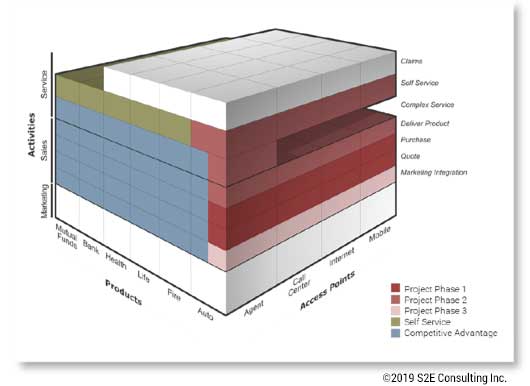The need for business architecture in organizations has never been greater than it is today, as we must continually sense and respond to opportunity and change, both of which abound. Though the business architecture discipline continues to gain traction at an ever-increasing pace, how we practice it is critical for its adoption and effectiveness. This Advisor provides an overview of the importance of using visual techniques as part of a business architecture practice and highlights the use of visual design.
According to research, we retain 10% of what we hear, 20% of what we read, but a full 80% of what we see. Further, people process visuals 60,000 times faster than text. Visuals matter, and for a business architecture practice to be effective, it must connect with people on a human level and in ways that build true understanding. Leveraging visuals is particularly important for a business architecture practice in order to:
- Influence outcomes. We use business architecture to support analysis of and decision making for some of the most important activities within an organization, such as agreeing upon what the future looks like for a business transformation or where to invest across portfolios. Good visualizations and storytelling are critical to help represent and convey information in a useful, accurate, and compelling way so that the right decisions can be made.
- Show differently. The way we behave as architects needs to align with today’s world and approaches: beautiful design, a design mindset, co-creation, and agility. Overly detailed Visio diagrams, lots of words, and academic approaches rarely resonate with most audiences.
- Enhance value. Incorporating additional visual, co-creation techniques into the way business architects work creates new value in interactions, such as allowing people to come to consensus more quickly or referring back to a visual record of the discussion. Having some level of competency in these techniques also helps individual business architects differentiate themselves, create more demand, and enhance marketability.
What Is Visual Design for Business Architecture?
This is the basic — but highly important — concept of creating well-designed, high-quality visuals to support various business architecture activities. Visuals might include graphics within presentations or documents, infographics, posters, intranet content, and so on. There are professionals who focus on the graphic design, but also true presentation designers who act as a strategic partner to talk through the concept for a work product (e.g., presentation, pitch deck, illustration) with the person requesting assistance and who then designs the desired product in accordance with those needs and their expertise.
How It Helps
Engaging graphics draw people in. This is particularly important in our world, where beautiful design is ubiquitous, and so, to some extent, good graphics are just a prerequisite for a business architecture team or any team. Effective graphics, which help represent information in a useful way, facilitate understanding, good decision making, and communication. Architecture can be abstract, sometimes ambiguous, and difficult to understand at a glance. Good graphics can help make the concepts clearer and more relatable.
When to Use It
A basic level of clean and effectively designed graphics is important in every case (and an opportunity for improvement for some practitioners). However, certain situations, such as major executive presentations, especially those where new concepts are being presented, may warrant investing in assistance from a professional graphic or presentation designer. Assistance may include heatmaps, current and target architecture diagrams, strategic roadmaps, and dashboards. Various aspects of socializing the business architecture practice internally could benefit from good graphic design as well, such as an infographic, poster, or well-designed presentation that describes what the business architecture team does.
For example, instead of a slide with bullet points, the illustration in Figure 1, designed by presentation designer James Jones, has been widely used to concisely communicate the scope for an enterprise-wide business transformation, based on the dimensions of activities, products, and access points.

[For more from the author on this topic, see “Visual Business Architecture: Approaching the Discipline Differently.”]



